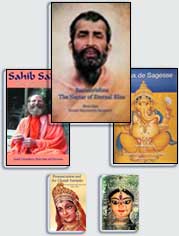
During the course of this yatra, the sadhana we have performed consists of chanting a collection of different scriptures, one right after another. Swamiji told that in his younger years, when he was performing intense tapasya in the Himalayas, his sadhana mostly consisted of Chandi Samputs, along with other scriptures.
Comparing the two sadhana approaches, Swamiji has found that the sadhana we are doing on this trip, reciting various scriptures one after another, is even more empowering than the Chandi Samputs.
By chanting Bhagavad Gita, Pancha Ratna, Chandi Path, Devi Gita, Guru Gita and many other sahasranams together, we get an amazing cross section of the inspiration and philosophy of Sanatana Dharma (eternal ideal of perfection).
As we recite the spectrum of scriptures, we become part of all of the traditions contained therein. We get to truly become Savarni, He who belongs to all colors, tribes, castes, and creeds. Everywhere we go, people have respect for our sadhana and are inspired to see all the different sects of Sanatana Dharma joined together in one worship.
As we move from one recitation to another, there is endless flow of wisdom and devotion which is presented in so many engaging and inspiring ways. Swamiji has said that the Shatakshara Samput of the Chandi takes eight hours, and we are already well beyond that!
(Note: Shata means 100 and akshara means syllables. The Shatakshara Samput for Chandi Path is 100 syllables consisting of the Tryambakam mantra (32), Jatavedase Mantra (44) and the Gayatri Mantra (24). These mantras are recited before and after each of the 700 verses of the Chandi Path.)
With such an amazing collection of texts translated by Swamiji, we could just keep going and going (and we do!) We get to enjoy so many of the various attitudes presented in the scriptures. Sometimes they are a story about Gods, Goddesses, and Rishis; at other times a philosophical discussion, a description of divinity and divine qualities, a list of the names of God, or a song of praise to one form or another.
As we chant, our rhythm and pranayama remain consistent throughout, yet the variety of meanings and ways of remembering divinity play in our consciousness.
Each night we read the translations of what we chanted during the day and find new inspiration of how to make our lives more divine, just as the characters in the story did.
We aren’t doing something new. The Rishis always held respect for and worshiped all of the various ideas and aspects of the Divine. They were universal in that they praised all forms of divinity and wrote songs and hymns for each manifestation of the Divine.
As an example, the Rishi Veda Vyasa is said to be the author of both the Mahabharata, from which came the Bhagavad Gita, and the Srimad Devi Bhagavatam, from which came the Devi Gita.
He is even said to be the author of all 18 Puranas, from which came the Chandi Path, the sahasranams of different Gods and Goddesses, the Guru Gita, and many other songs of praise.
The sadhana we are performing on this yatra, where we worship all forms and manifestations of divinity, affords the privilege of moving closer to the universal attitude that the Rishis have reflected.